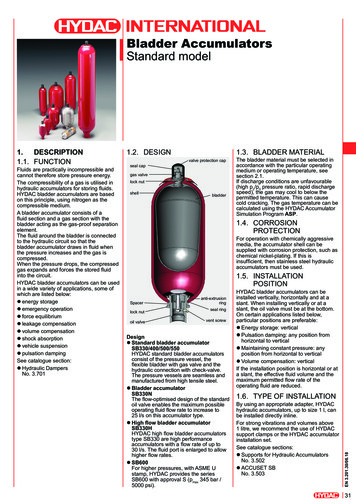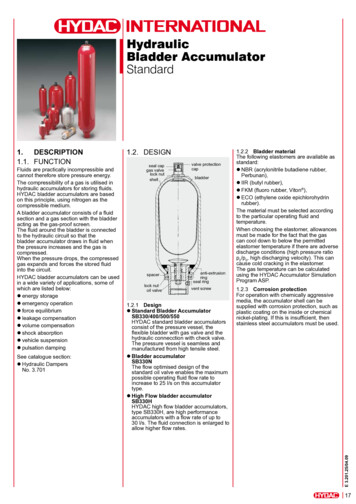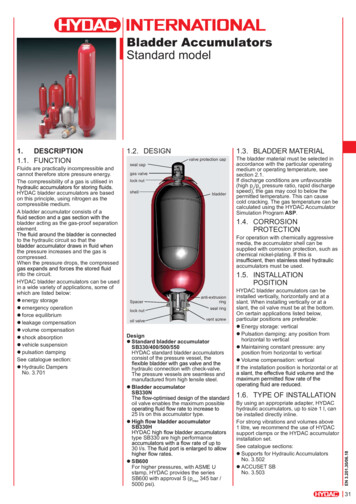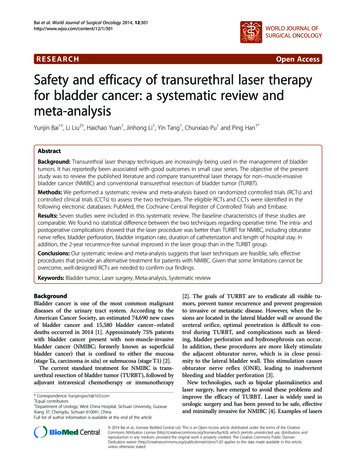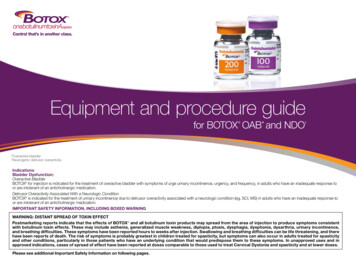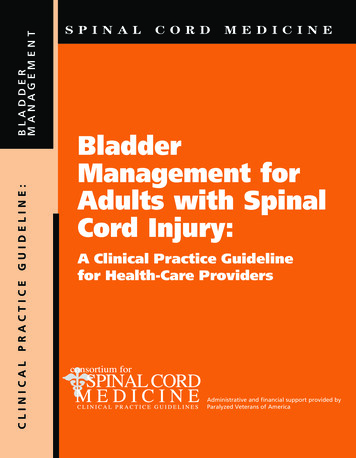
Transcription
BLADDERMANAGEMENTCLINICAL PRACTICE GUIDELINE:SPINALCORDMEDICINEBladderManagement forAdults with SpinalCord Injury:A Clinical Practice Guidelinefor Health-Care ProvidersAdministrative and financial support provided byParalyzed Veterans of America
Consortium for Spinal Cord MedicineMember OrganizationsAmerican Academy of Orthopedic SurgeonsAmerican Academy of Physical Medicine and RehabilitationAmerican Association of Neurological SurgeonsAmerican Association of Spinal Cord Injury NursesAmerican Association of Spinal Cord Injury Psychologists and Social WorkersAmerican College of Emergency PhysiciansAmerican Congress of Rehabilitation MedicineAmerican Occupational Therapy AssociationAmerican Paraplegia SocietyAmerican Physical Therapy AssociationAmerican Psychological AssociationAmerican Spinal Injury AssociationAssociation of Academic PhysiatristsAssociation of Rehabilitation NursesChristopher Reeve FoundationCongress of Neurological SurgeonsInsurance Rehabilitation Study GroupInternational Spinal Cord SocietyParalyzed Veterans of AmericaUnited Spinal AssociationU.S. Department of Veterans Affairs
CLINICALPRACTICEGUIDELINESpinal Cord MedicineBladder Management for Adultswith Spinal Cord Injury:A Clinical Practice Guidelinefor Health-Care ProvidersConsortium for Spinal Cord MedicineAdministrative and financial support provided by Paralyzed Veterans of America Copyright 2006, Paralyzed Veterans of AmericaThis guideline has been prepared based on the scientific and professional information available in2006. Users of this guideline should periodically review this material to ensure that the adviceherein is consistent with current reasonable clinical practice.August 2006ISBN: 0-929819-19-5
CLINICAL PRACTICE GUIDELINETable of ContentsivForewordvPrefaceviAcknowledgmentsv iiPanel MembersviiiContributors1Summary of Recommendations7The Consortium for Spinal Cord MedicineGUIDELINE DEVELOPMENT PROCESSMETHODOLOGY13IntroductionANATOMY AND PHYSIOLOGY OF THE UPPER AND LOWER URINARY TRACTSUPPER URINARY TRACTLOWER URINARY TRACTNEUROANATOMY OF THE LOWER URINARY TRACTVOIDING CENTERSCLASSIFICATION OF VOIDING DYSFUNCTIONUROLOGIC EVALUATIONUROLOGY FOLLOW-UP17RecommendationsINTERMITTENT CATHETERIZATIONCREDÉ AND VALSALVAINDWELLING CATHETERIZATIONREFLEX VOIDINGALPHA-BLOCKERSBOTULINUM TOXIN INJECTIONURETHRAL STENTSTRANSURETHRAL SPHINCTEROTOMYELECTRICAL STIMULATION AND POSTERIOR SACRAL RHIZOTOMYBLADDER AUGMENTATIONCONTINENT URINARY DIVERSIONURINARY DIVERSIONCUTANEOUS ILEOVESICOSTOMY42Recommendations for Future Research43Appendix A: Economic Considerations for BladderManagement Methods45References50Indexiii
ivBLADDER MANAGEMENT FOR ADULTS WITH SPINAL CORD INJURYForewordeurogenic bladder occurs in most individuals who have a spinal cord injury(SCI). During World War I, 39 percent of those with spinal cord injury diedfrom acute urinary tract infections (UTIs). During World War II, this numberdropped to 10 percent, but the most common cause of death from spinal cordinjury became renal failure.Currently, although UTIs occur frequently in those with SCI, death from thiscause is extremely unusual. And less than 3 percent of deaths following SCI arenow attributable to chronic renal failure. This dramatic decline in morbidity andmortality from urological causes has been a result of the advent of antibiotics,effective bladder management, and frequent monitoring of the upper and lowerurinary tracts.This guideline was developed to describe the various methods of bladdermanagement in adults with SCI. The panel decided to address this guideline notonly to caregivers who are familiar with SCI, but also to those who infrequentlymanage individuals with SCI. The panel also decided not to recommend one single method of management, but rather to discuss the indications, advantages anddisadvantages, nursing issues, and economic considerations of each of the mostpopular methods. There are a couple of reasons for this. The first is that there isno strong scientific evidence that one method is superior to another. The secondis that health-care providers who are familiar with the various methods can offerthe best help and advice to the individuals in their care.It is important that individuals with SCI understand the pros and cons of thevarious methods of bladder management in a fair and unbiased way. Patient education should include a balanced discussion of the effect each method will haveon health, lifestyle, and sexuality, as the comparative cost of each method and theavailability of expert follow-up. The decision of which method to choose can thenbe made after all of the various factors have been weighed.In developing this guideline, panel members looked carefully at the scientificliterature and at expert opinion. The goal was to provide both individuals withSCI and the health-care providers who advise them with the best and most up-todate information on the wide variety of bladder management techniques availableto them. The guideline recommendations consider who is—and who is not—agood candidate for each method as well as the associated contraindications. Indoing so the panel sought to list the most common attributes of each method,based on the literature, rather than try to discuss every possible reason why aparticular method should or should not be used.I hope this guideline will help you in your practice as you care for and educate SCI individuals with neurogenic bladders. I also hope that the guideline willstimulate further clinical studies in this important area.NTodd A. Linsenmeyer, MDChairman
CLINICAL PRACTICE GUIDELINEPrefacerological complications, including urinary tract infections and renal failure,were at one time the number one killer of persons with spinal cord injury.Thanks primarily to dramatic improvements in the management of the neurogenic bladder over the past 40 years, the lifespan of people with SCI nowapproaches that of the general population. Although UTIs continue to be a frequent complication for many with SCI, renal failure is rare.No other organ system has been studied as extensively in SCI as the urological system. And no other organ system has sparked such heated debate amongspecialists in terms of management in SCI. The Consortium for Spinal Cord Medicine brought together a team of experts in SCI urologic management to weighthe scientific evidence available and produce a document that identifies the verybest practices for modern bladder management in individuals with SCI. Here inone document are the various options for bladder management, laid out in clearand concise language, and accompanied by the scientific arguments for the useof each option.Individuals today have lots of options available for safe management of thebladder following SCI. However, as with many decisions in medicine, there israrely one perfect solution that will meet each person’s needs. A comprehensiveassessment of the options available is necessary to find the managementapproach that will best fit his or her unique anatomy, neurophysiology, functionalabilities, medical comorbidities, and social life. The decision often requires choosing the best option from among several imperfect solutions. To make the processsuccessful requires the expertise of many persons, the most important of whomis the individual with SCI. Because compliance with any bladder managementapproach is the key to its success, it is essential for the individual with SCI to beboth knowledgeable about and comfortable with daily implementation of the program.This document is the ninth clinical practice guideline published by the Consortium for Spinal Cord Medicine under the auspices of the Paralyzed Veterans ofAmerica. It offers exceptional insight into the appropriate management techniques of the neurogenic bladder based on science and clinical expertise. It doesnot prescribe one bladder management technique over another, but rather provides a compendium of management options, many of which may be appropriatefor any one individual.In creating this document, each distinguished guideline development panelmember brought to the table her or his energy, dedication, and passion for thecare of people with SCI. The panel worked as a magnificent team under the leadership of panel chair Todd Linsenmeyer, MD, who deserves special thanks fromthe consortium steering committee for his enduring commitment and leadership.Special thanks also go to representatives of the consortium’s 21 member organizations, who thoughtfully and critically reviewed the draft in its various forms.Their input was essential to making this document one that will improve both thequality of care and the quality of life for persons with SCI.UMichael Priebe, MDChair, Steering Committeev
viBLADDER MANAGEMENT FOR ADULTS WITH SPINAL CORD INJURYAcknowledgmentshe chairman and members of the bladder management guideline developmentpanel wish to express special appreciation to the individuals and professionalorganizations who are members of the Consortium for Spinal Cord Medicineand to the expert clinicians and health-care providers who reviewed the draftdocument. Special thanks go to the consumers, advocacy organizations, and staffof the numerous medical facilities and spinal cord injury rehabilitation centerswho contributed their time and expertise to the development of this guideline.Karen Schoelles, MD, and colleagues at MetaWorks, Inc., Medford, Massachusetts, served as consultant methodologists. They masterfully conducted theinitial and secondary-level literature searches, evaluated the quality and strengthof the scientific evidence, constructed evidence tables, and graded the quality ofresearch for all identified literature citations. This included an evaluation of currently used grading schema and development of a new, innovative method forgrading specialized spinal cord injury and related rehabilitation research.Members of the consortium steering committee, representing 22 professional, payer, and consumer organizations, were joined in the guideline developmentprocess by more than 35 expert reviewers. Through their critical analysis andthoughtful comments, the recommendations were refined and additional supporting evidence from the scientific literature was identified. The quality of the technical assistance by these dedicated reviewers contributed significantly to theprofessional consensus building that is achieved through the guideline development process. Attorney William H. Archambault conducted a comprehensiveanalysis of the legal and health policy issues associated with this complex, multifaceted topic.The guideline development panel is grateful for the many technical supportservices provided by various departments of the Paralyzed Veterans of America.In particular, the panel recognizes J. Paul Thomas and Kim S. Nalle in the consortium coordinating office for their help in organizing and managing the process;James A. Angelo and Kelly Saxton in the PVA Communications Program for theirguidance in writing, formatting, and creating art; and medical editor Joellen Talbot for her excellent technical review and editing of the clinical practice guideline. Appreciation is expressed for the steadfast commitment and enthusiasticadvocacy of the entire PVA board of directors and of PVA’s senior officers, including National President Randy L. Pleva, Sr.; Immediate Past President Joseph L.Fox, Sr.; Acting Executive Director Homer S. Townsend, Jr.; Acting Deputy Executive Director Louis Irvin; and Director of Research, Education, and PracticeGuidelines Thomas E. Stripling. Their generous financial support has made theConsortium for Spinal Cord Medicine and its guideline development process asuccess.T
CLINICAL PRACTICE GUIDELINEPanel MembersTodd A. Linsenmeyer, MDPanel Chair(Urology)Kessler Institute for RehabilitationWest Orange, NJ(Urology and Physical Medicine and Rehabilitation)UMDNI — New Jersey Medical SchoolNewark, NJDonald R. Bodner, MD(Urology)Louis Stokes VA Medical Center and University Hospitals ClevelandCleveland, OHGraham H. Creasey, MD(Spinal Cord Injury Medicine)Louis Stokes VA Medical Center and MetroHealth Medical CenterCleveland, OHBruce G. Green, MD(Urology)Sandy Springs Urology GroupAtlanta, GASuzanne L. Groah, MD, MSPH(Physical Medicine & Rehabilitation)National Rehabilitation HospitalWashington, DCAngela Joseph, RN, MSN(SCI Nursing)VA San Diego Healthcare SystemSan Diego, CAL. Keith Lloyd, MD(Urology)University of Alabama at BirminghamBirmingham, ALInder Perkash, MD(Urology)VA Palo Alto Health Care System and Stanford UniversityPalo Alto, CAJohn S. Wheeler, MD(Urology)Edward Hines, Jr., HospitalHines, ILLoyola University Medical CenterMaywood, ILvii
viiiBLADDER MANAGEMENT FOR ADULTS WITH SPINAL CORD INJURYContributorsConsortium Member Organizationsand Steering CommitteeRepresentativesAmerican Academy of Orthopedic SurgeonsE. Byron Marsolais, MDAmerican Academy of Physical Medicine and RehabilitationMichael L. Boninger, MDAmerican Association of Neurological SurgeonsPaul C. McCormick, MDAmerican Association of Spinal Cord Injury NursesLinda Love, RN, MSAmerican Association of Spinal Cord Injury Psychologists andSocial WorkersRomel W. Mackelprang, DSWAmerican College of Emergency PhysiciansWilliam C. Dalsey, MD, FACEPAmerican Congress of Rehabilitation MedicineMarilyn Pires, MS, RN, CRRN-A, FAANAmerican Occupational Therapy AssociationTheresa Gregorio-Torres, MA, OTRAmerican Paraplegia SocietyLawrence C. Vogel, MDAmerican Physical Therapy AssociationDeborah Backus, PT, PhDAmerican Psychological AssociationDonald G. Kewman, PhD, ABPPAmerican Spinal Injury AssociationMichael M. Priebe, MDAssociation of Academic PhysiatristsWilliam O. McKinley, MDAssociation of Rehabilitation NursesAudrey Nelson, PhD, RN, FAANChristopher Reeve FoundationSamuel MaddoxCongress of Neurological SurgeonsPaul C. McCormick, MDInsurance Rehabilitation Study GroupLouis A. Papastrat, MBA, CDMS, CCMInternational Spinal Cord SocietyJohn F. Ditunno, Jr., MDParalyzed Veterans of AmericaJames W. Dudley, BSMEUnited Spinal AssociationVivian Beyda, DrPHU.S. Department of Veterans AffairsMargaret C. Hammond, MDExpert ReviewersAmerican Academy of Physical Medicine and RehabilitationFrederick S. Frost, MDCleveland Clinic, Cleveland, OHLance L. Goetz, MUniversity of Texas-Southwestern Medical Center,Dallas, TXDaniel P. Lammertse, MDCraig Hospital, Englewood, COAmerican Association of Spinal Cord Injury NursesKathleen L. Dunn, RN, MS, CRRN-A, CNSVA San Diego Healthcare System, San Diego, CAEvelyn Kliever, MA, RN, CRRN-A, CURNMiller-Dwan Rehabilitation Center, Duluth, MNAmerican Association of Spinal Cord Injury Psychologists andSocial WorkersRebecca J. Adcock, PhDINTEGRIS Jim Thorpe Rehabilitation Hospital,Oklahoma City, OKMichael Dunn, PhDVA Palo Alto Health Care System, Palo Alto, CAAmerican Congress of Rehabilitation MedicineDavid Ginsberg, MDRancho Los Amigos National Rehabilitation Center,Downey, CAMichael D. Scott, MDRancho Los Amigos National Rehabilitation Center,Downey, CAMary Young, RN, MSRetiredAmerican Occupational Therapy AssociationSuzanne M. Krenek, MOT, OTR, ATPThe Institute for Rehabilitation and Research, Houston, TXRafferty Laredo, MA, OTR, ATPThe Institute for Rehabilitation and Research, Houston, TXAmerican Paraplegia SocietyMichael Kennelly, MDCarolinas Medical Center, Charlotte, NCPatrick J. Shenot, MDThomas Jefferson University, Philadelphia, PA
CLINICAL PRACTICE GUIDELINEAmerican Psychological AssociationInsurance Rehabilitation Study GroupStanley Durchame, PhDBoston University Medical Center, Boston, MAAdam Seidner, MD, MPHTravelers Insurance Company, Hartford, CTMichelle A. Meade, PhDVirginia Commonwealth University, Richmond, VAJames Urso, BASt. Paul Travelers Workers, Hartford, CTAmerican Spinal Injury AssociationSam Colachis, MDThe Ohio State University, Columbus, OHAssociation of Academic PhysiatristsAustin I. Nobunaga, MD, MPHUniversity of Cincinnati College of Medicine,Cincinnati, OHAssociation of Rehabilitation NursesCindy Gatens, MN, RN, CRRN-AThe Ohio State University Medical Center–Dodd HallRehabilitation Hospital, Columbus, OHAloma Gender, RN, MSN, CRRNChristus St. Michael Rehabilitation Hospital,Texarkana, TXChristina Mumma, PhD, RNUniversity of Alaska School of Nursing, Anchorage, AKInternational Spinal Cord SocietyJean Jacques Wyndaele, MD, DSCI, PhD, FEBU, FISCOSUniversity of Antwerp, Antwerp, BelgiumU.S. Department of Veterans AffairsMark D. Fredrickson, MD, FAAPMRSouth Texas Veterans Health Care System, San Antonio, TXVidya Jayawardena, MDHunter Holmes McGuire VA Medical Center,Richmond, VABernard A. Nemchausky, MDEdward Hines, Jr., VA Hospital, Hines, ILix
CLINICAL PRACTICE GUIDELINESummary of RecommendationsIntermittent Catheterization1. Consider intermittent catheterization for individuals who have sufficient hand skills or a willingcaregiver to perform the catheterization.2. Consider avoiding intermittent catheterization inindividuals with SCI who have one or more of thefollowing:Inability to catheterize themselves.5. Institute clean intermittent catheterization teachingand training for individuals prior to discharge fromthe acute phase of rehabilitation.6. Consider sterile catheterization for individuals withrecurrent symptomatic infections occurring withclean intermittent catheterization.7. Investigate and provide treatment for individualson intermittent catheterization who leak urinebetween catheterizations.A caregiver who is unwilling to performcatheterization.8. Monitor individuals using this method of bladdermanagement.Abnormal urethral anatomy such as stricture,false passages, and bladder neck obstruction.Credé and ValsalvaBladder capacity less than 200 ml.1. Consider the use of Credé and Valsalva for individuals who have lower motor neuron injuries withlow outlet resistance or who have had a sphincterotomy.Poor cognition, little motivation, or inabilityor unwillingness to adhere to thecatheterization time schedule.High fluid intake regimen.Adverse reaction to passing a catheter intothe genital area multiple times a day.Tendency to develop autonomic dysreflexiawith bladder filling despite treatment.3. Advise individuals with SCI of the potential forcomplications with intermittent catheterization,such as:Urinary tract infections.Bladder overdistention.2. Consider avoiding Credé and Valsalva as primarymethods of bladder emptying.3. Consider avoiding Credé and Valsalva methods inindividuals with:Detrusor sphincter dyssynergia.Bladder outlet obstruction.Vesicoureteral reflux.Hydronephrosis.4. Advise individuals with SCI of the potential forcomplications with Credé and Valsalva, such as:Urinary incontinence.Urethral trauma with hematuria.Urethral false passages.Incomplete bladder emptying.High intravesical pressure.Urethral stricture.Developing and/or worsening vesicoureteralreflux.Autonomic dysreflexia (in those with injuriesat T6 and above).Developing and/or worseninghydronephrosis.Bladder stones.Abdominal bruising.4. If bladder volumes consistently exceed 500 ml,adjust fluid intake, increase frequency of intermittent catheterization, or consider an alternativebladder management method.Possible hernia, pelvic organ prolapse, orhemorrhoids.1
2BLADDER MANAGEMENT FOR ADULTS WITH SPINAL CORD INJURYIndwelling Catheterization1. Consider indwelling catheterization for individualswith:5. Advise individuals of the long-term complicationsassociated with indwelling catheterization, whichinclude:Bladder stones.Poor hand skills.Kidney stones.High fluid intake.Urethral erosions.Cognitive impairment or active substanceabuse.Epididymitis.Elevated detrusor pressures.Lack of success with other less invasivebladder management methods.Need for temporary management ofvesicoureteral reflux.Limited assistance from a caregiver, makinganother type of bladder management notfeasible.2. Consider using suprapubic catheterization forindividuals with:Urethral abnormalities, such as stricture,false passages, bladder neck obstruction, orurethral fistula.Urethral discomfort.Recurrent urethral catheter obstruction.Recurrent symptomatic urinary ephrosis from bladder wall thickeningor fibrosis.Bladder cancer.6. Conduct more frequent cystoscopic evaluations forindividuals with chronic indwelling catheters thanfor those with nonindwelling methods of bladdermanagement.7. Consider the use of anticholinergics in individualswith suprasacral lesions using chronic indwellingcatheterization.Reflex VoidingDifficulty with urethral catheter insertion.Perineal skin breakdown as a result of urineleakage secondary to urethral incompetence.Psychological considerations such as bodyimage or personal preference.1. Consider using reflex voiding for males whodemonstrate post-spinal shock with adequatebladder contractions and have:A desire to improve sexual genital function.Sufficient hand skills to put on a condomcatheter and empty the leg bag, or a willingcaregiver.Prostatitis, urethritis, or epididymo-orchitis.Poor compliance with fluid restriction.3. Consider avoiding urethral catheterization inindividuals with SCI:Immediately following acute SCI if urethralinjury is suspected, especially after pelvictrauma (blood at the urethral meatus andperineal and scrotal hematomas may beindicative of urethral trauma).If bladder capacity is small, with forcefuluninhibited contractions despite treatment.4. Consider indwelling catheterization for individualswho are at risk of genitourinary complicationsbecause of elevated detrusor pressures.Small bladder capacity.Small post-void residual volumes.Ability to maintain a condom catheter inplace.2. Conduct a thorough urodynamic evaluation todetermine whether reflex voiding is a suitablemethod for a particular individual.3. Consider not using reflex voiding as a method ofbladder management in individuals who:Have insufficient hand skills or caregiverassistance.
CLINICAL PRACTICE GUIDELINEAre unable to maintain a condom catheter inplace.Are female.Have incomplete bladder emptying despitetreatment to facilitate voiding.Have high-pressure voiding despite treatmentto facilitate voiding.Develop autonomic dysreflexia despitetreatment to facilitate voiding.4. Advise individuals of the potential for complications with reflex voiding, such as:als with high-level spinal cord injuries because ofthe potential for orthostatic hypotension.4. Use phosphodiesterase inhibitors with caution inindividuals with a high-level SCI who are on alphablockers. Particular caution should be used ifalpha-blockers and PDE5 inhibitors are prescribedtogether.5. Advise individuals of the potential for complications of alpha-blockers, such as orthostatichypotension.Botulinum Toxin InjectionCondom catheter leakage and/or failure.Penile skin breakdown from external condomcatheter .Urethral fistula.Symptomatic UTI.Poor bladder emptying.High intravesical voiding pressures.Autonomic dysreflexia in those with injuriesat T6 and above.5. First consider the use of the following nonsurgicalmethods to help decrease detrusor sphincterdyssynergia in individuals who use reflex voidingas their method of bladder management:1. Consider the use of botulinum toxin injections intothe sphincter to help improve voiding in individuals with SCI with detrusor sphincter dyssynergia.2. Monitor individuals after botulinum toxin injectionsand inform them that onset may be delayed up to1 week and that the drug may lose its effectiveness in 3 to 6 months.3. Consider avoiding the injection of botulinum toxininto the sphincter of SCI individuals who:Have a neuromuscular disease.Have a known allergy to or previous adverseeffect from botulinum toxin.Are currently on an aminoglycoside.Alpha-blockers.Have insufficient hand skills or caregiverassistance.Botulinum toxin injection into the urinarysphincter mechanism.Are unable to maintain a condom catheter.6. To ensure low-pressure voiding during reflex voiding, consider the use of two surgical methods:Transurethral sphincterotomy.Are female.4. Advise individuals with SCI of the potential forcomplications of botulinum toxin injections intothe sphincter, such as:Endourethral stents.Alpha-Blockers1. Consider the use of alpha-blockers on their own oras a supplement to other forms of treatment, suchas transurethral sphincterotomy.2. Consider avoiding alpha-blockers in individualswho have symptomatic hypotension.3. When first prescribing, instruct the individual totake alpha-blockers at night, when supine. Theseinstructions are particularly important for individu-Autonomic dysreflexia during the injection(T6 and above).Hematuria during the injection.5. Consider injecting botulinum toxin into the detrusor muscle of individuals on intermittent catheterization with detrusor overactivity.3
4BLADDER MANAGEMENT FOR ADULTS WITH SPINAL CORD INJURYEndourethral StentsTissue growth into the stent blocking urineflow.1. Consider endourethral stents to treat detrusorsphincter dyssynergia in individuals who want toreflex void and:Urethral pain.Have insufficient hand skills or caregiverassistance to perform intermittentcatheterization.Have a repeated history of autonomicdysreflexia.Experience difficult catheterization due tofalse passages in the urethra or secondarybladder neck obstruction.Have inadequate bladder drainage with severebladder wall changes, drop in renal function,vesicoureteral reflux, and/or stone disease.Have prostate-ejaculatory reflux with thepotential for repeated epididymo-orchitis.Experience failure with or intolerance toanticholinergic medications for intermittentcatheterization.Experience failure with or intolerance toalpha-blockers with reflex voiding.2. Consider the endourethral stent method ofdrainage as an alternative to transurethral sphincterotomy in individuals with SCI.3. Consider avoiding endourethral stents in individuals who:Have insufficient hand skills or caregiverassistance to manage a condom catheter.Are unable to maintain a condom catheter.Are female.Have urethral abnormalities.4. Advise individuals of the potential for complications of endourethral stents, such as:Stone encrustation.Stent migration.Persistence of autonomic dysreflexia.Possible need for removal or replacement.Difficulty with removal.Possible urethral stricture after removal ofstent.Urethral trauma.Transurethral Sphincterotomy1. Consider transurethral sphincterotomy (TURS) totreat detrusor sphincter dyssynergia in males withSCI who want to use reflex voiding and who:Have insufficient hand skills or caregiverassistance to perform intermittentcatheterization.Have a repeated history of autonomicdysreflexia with a noncompliant bladder.Experience difficult catheterization due tofalse passages in the urethra or secondarybladder neck obstruction.Have inadequate bladder drainage with severebladder wall changes, drop in renal function,vesicoureteral reflex, and/or stone disease.Have prostate-ejaculatory reflux with thepotential for repeated epididymo-orchitis.Experience failure with or intolerance toanticholinergic medications for intermittentcatheterization.Experience failure with or intolerance toalpha-blockers with reflex voiding.2. Consider avoiding sphincterotomy in males with asmall retractable penis unable to hold an externalcollecting device unless a penile implant is plannedfollowing TURS.3. Advise individuals with SCI of the potential forcomplications of a sphincterotomy, such as:Significant intraoperative and perioperativebleeding.Clot retention.Prolonged drainage with a large diametercatheter.Urethral stricture.Erectile dysfunction.Ejaculatory dysfunction.Reoperation in 30 to 60 percent of cases.4. Consider laser sphincterotomy the procedure ofchoice for transurethral sphincterotomy, dependingupon the availability of laser equipment.
CLINICAL PRACTICE GUIDELINEElectrical Stimulation andPosterior Sacral Rhizotomy1. Consider electrical stimulation and posterior sacralrhizotomy in individuals with:High post-void residual volumes.Chronic or recurrent urinary tract infection.Problems with catheters.Reflex incontinence.Reduced bladder capacity and compliance,caused by detrusor hyperreflexia.Intolerance of anticholinergic medication.Detrusor sphincter dyssynergia.Bladder Augmentation1. Consider bladder augmentation for individuals whohave:Intractable involuntary bladder contractionscausing incontinence.The ability and motivation to performintermittent catheterization.The desire to convert from reflex voiding toan intermittent catheterization program.A high risk for upper tract deteriorationsecondary to hydronephrosis and/orureterovesical reflux as a result of highpressure detrusor sphincter dyssynergia.2. Consider bladder augmentation for females withparaplegia.Autonomic dysreflexia.2. Avoid electrical stimulation combined with posterior sacral rhizotomy for:Individuals who have poor or absent bladdercontractions.Individuals who are unable to expand thebladder due to fibrosis.Females who are unable to transfer or betransferred or to manage clothing.3. Consider bladder augmentation for individuals whoare at high risk for upper tract deterioration secondary to hydronephrosis and/or ureterovesicalreflux as a result of high pressures, secondary topoor bladder wall compliance, and/or detrusorsphincter dyssynergia.4. Avoid augmentation for individuals who have:Inflammatory bowel disease.Pelvic irradiation.Males who are unwilling to lose reflexerection.3. Advise individuals with SCI of the potential for complications of posterior sacral rhizotomy, such as:Loss of reflex erection and reflex ejaculation.Loss of sacral sensation.Reduction of reflex defecation.Transient nerve damage (rarely long term).4. Advise individuals with SCI of the potential forcomplications of electrical stimulation, such as:Contamination of the device.Malfunction of the device.Transient nerve damage (rarely long term).Severe abdominal adhesions from previoussurgery.Compromised renal function.5. Advise ind
panel wish to express special appreciation to the individuals and professional . advocacy of the entire PVA board of directors and of PVA's senior officers, includ-ing National President Randy L. Pleva, Sr.; Immediate Past President Joseph L. Fox, Sr.; Acting Executive Director Homer S. Townsend, Jr.; Acting Deputy Exec-utive Director Louis .
